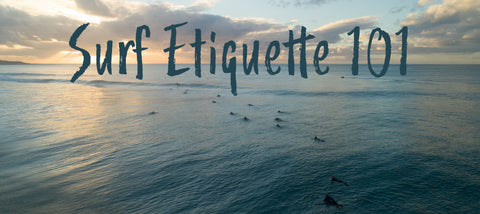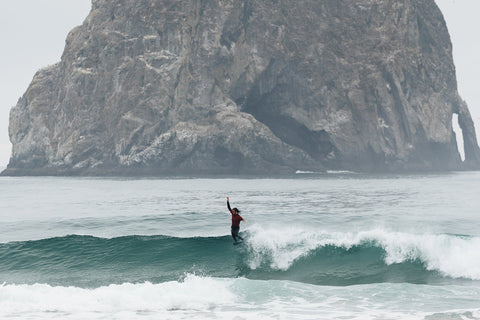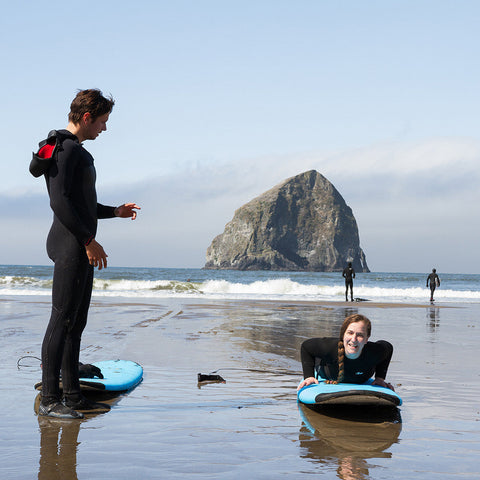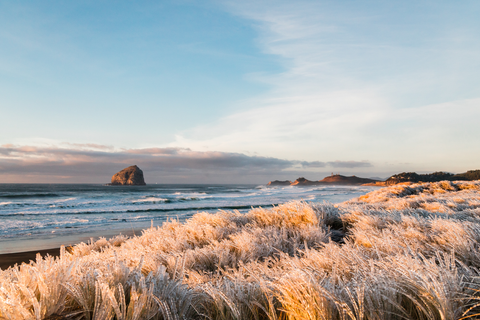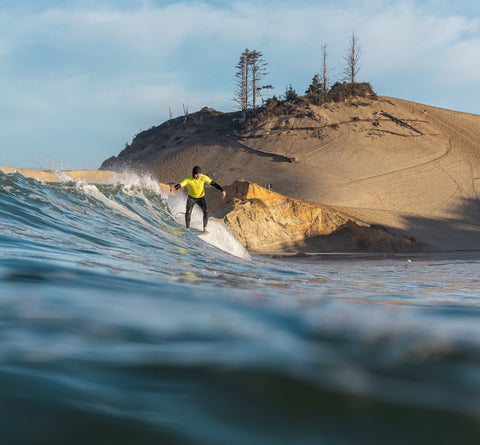We get asked in the shop all the time about proper etiquette in the water and line-up. We thought it would make a good subject for a blog post and decided to compile a list of basic rules that we all should follow. These guidelines have been established over the years to keep people safe and to give some form of rules in a sport that prides itself in not having any. By no means is this a definitive list of everything you need to know, but it’s a great place to start.

A complicated lineup that requires a solid knowledge of surf etiquette.
Picking a Peak
- Be aware of your surroundings and situation. It's one thing to paddle out to a crowded and popular spot, but totally different if its a little more remote. If you find yourself at a less frequented break and see only a few people surfing, that's not always an invitation to paddle out. Even just paddling out to the next wave down the beach is usually extremely appreciated by those in the water. When you feel the time is right, slowly make your way over to the peak you want to be at.
- It is never a good idea to paddle out with a crew of people. If you're with multiple friends, stagger your paddle, or better yet, just go find a peak to yourselves. You will have a lot more fun and not disappoint the people who are already in the line-up. You end up enjoying your session even more knowing it's just you and your crew!

At a place with multiple peaks like this, it's worth just paddling to the empty peak rather than the one with people on it.

A popular spot like this still requires you to have excellent etiquette in order to get waves and maintain the peace.
Paddling out
- Never paddle directly into the line up. Start either to the left or right of the pack of surfers sitting on the peak and far enough away to avoid getting in the way of someone riding a wave. If you do find yourself in someone’s path, it is your responsibility to avoid them. This usually means paddling into the breaking section of the wave and behind the surfer. Your punishment for getting in the way is taking the lip on your head. It’s not fun getting pounded, but you shouldn’t have paddled out there!
- When you do reach the line-up, congratulations: you are now the low man on the totem pole. This means you will be the last person to catch a set wave and should take your position accordingly furthest away from the peak.

Unidentified doing the right thing and taking the whitewater on the head to avoid getting in the way of team rider Tony Perez

Team rider Tony Perez making sure he's given Mattie Starr plenty of room to complete his turn while dealing with some paddling traffic of his own.
Catching waves
- You have been waiting patiently as everyone in front of you has taken their waves, and under no circumstances have you dropped in on someone as they came flying by you. To clarify, the closest surfer to the breaking section of the wave has priority. As we learned about when paddling out, these are the surfers that were there before you! The paddle out rule also applies every time you catch a wave and paddle back to the line-up. You got a wave and now it is someone else’s turn.
- It might be hard to resist, but when the person closest to the peak paddles for a wave do not also try to catch it. It is their wave and they have earned the right to catch it without you trying to battle for it. Your job is to be first alternate should a wave swing too wide for the person in first position to catch. Or, if said lead position surfer doesn’t paddle for a catchable wave (for whatever reason) it’s now your priority and you need to make a decision fast!
- Don’t snowball people (paddle for the wave and back out at the last second), crumbling the section in front of the deeper surfer, thus potentially ruining their wave, even if you didn’t end up dropping in on them.

Unknown in a bad spot, eventually forcing shop owner Jeff Mollencop to change his line. This is a tricky position to be in, and is sometimes just unavoidable. This person should have paddled further away from the peak and would have been less likely to make Jeff need to adjust.

A classic example of snowballing.
Sitting at the Peak
- You have now made your way to the peak, congratulations: don’t blow it! It’s up to you to pick any wave you want, but don’t pick the wrong one. If you paddle like crazy for it, but can’t catch it, you are now obligated to paddle to the end of the line-up. Seems unfair, but that’s the breaks.
- The power which comes from having first priority is that if someone decides to paddle past or under you, and steal your position, you have every right to drop in on them. They may think they pulled a fast one on you, but not true. You still hold the power and can stuff them into the pit if you want. This is a hard lesson, but one that needs to be fully understood.

Don't make it all the way through a lineup like this just to blow your wave. If you do, you'll have to start over.
Surfing on the Inside
- To avoid the power struggle happening at the peak, you might choose to surf the smaller waves on the inside. These are the waves that aren’t big enough to break on the outside peak and roll under the line-up and break closer to shore. All the same rules apply, but usually the peak is less defined and more random. So the rule regarding the surfer closest to the breaking section of the wave having priority outweighs the others. If you are going to surf on the inside, be aware of the people sitting outside of you waiting for sets, and be ready to scramble or take some waves on the head when a set does come.

If you're going to surf on the inside, be prepared to scramble out of the way when a set comes (and get ready to be sprayed).
The Surfing Pecking Order
- You might be out surfing and following all the rules, but someone keeps paddling past you and taking all the waves. Why isn’t he paying attention to the rules of priority? One good explanation might be the unwritten rules of the surfing caste system. Much like skiers or snowboarders who have season passes get certain priorities over the daily pass holders, surfers who have paid more to the wave bank get more benefits. Like golfers who pay for priority tee times or concert goers dropping tons of cash for front row seats, certain surfers have earned priority in the line up. But this is a discussion for another post…..

Every lineup in the world has a pecking order.

